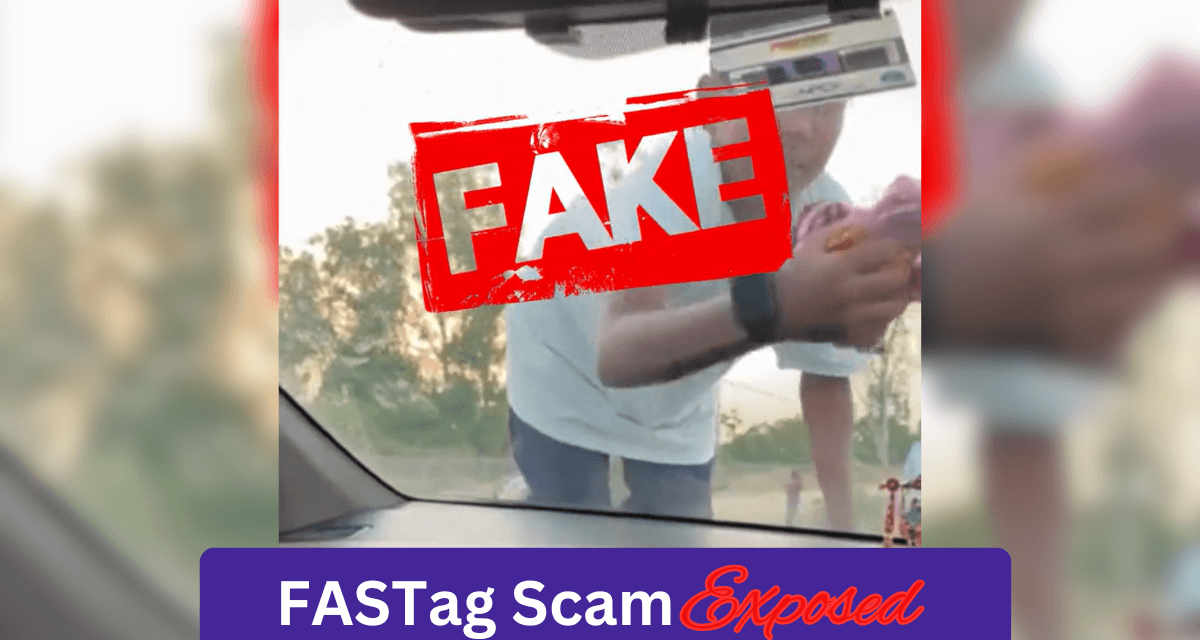

In recent days, a viral video on social media has caused panic among FASTag users, particularly those using Paytm FASTag. The video claims to expose a new scam where fraudsters can use smartwatches to scan FASTags and withdraw money from linked accounts. The alarming footage has led to concerns regarding the security of FASTag transactions and the potential risks associated with this widely used electronic toll collection system in India.
The controversial video shows two men sitting inside a car while a young boy cleans the car’s windshield. It is observed that the boy is wearing a smartwatch and attempts to scan the Paytm FASTag affixed to the car. Upon noticing this suspicious act, one of the men in the car tries to chase the boy, but he escapes. The other man then explains that the smartwatch on the boy’s wrist was supposedly capable of scanning the FASTag and deducting money from the linked Paytm account.
This video has spread rapidly on various social media platforms, leading to widespread panic among FASTag users. Many fear that scammers could exploit this method to siphon off money, even from vehicles parked on the roadside. Rumors have also emerged suggesting that Paytm FASTag might be insecure and that the company is working on a redesign to prevent such fraudulent activities.
Following the circulation of this video, both the National Payments Council of India (NPCI) and Paytm issued official statements debunking the claims. They clarified that the video is misleading and promotes misinformation about FASTag transactions.
According to Paytm, FASTag payments can only be initiated by authorized merchants who have undergone thorough verification and testing processes. The NPCI also released a statement explaining that it is technically impossible for an individual to scan a FASTag and withdraw money from the owner’s account. FASTag payments are strictly processed at toll plazas through RFID (Radio Frequency Identification) technology, ensuring that unauthorized transactions do not take place.
Must Read --> How to Check FASTag Balance with Vehicle Number?
For a FASTag transaction to be processed successfully, several key components must interact securely. Each toll plaza in India is assigned a unique identifier, and it is linked to an acquirer bank. These identifiers are then mapped to the National Electronic Toll Collection (NETC) system, along with specific geo-location codes for each toll plaza.
A successful transaction requires communication between three critical entities:
Unique Toll ID – A unique identifier for each toll plaza.
Acquirer Bank – The bank associated with the toll plaza that processes payments.
NETC FASTag System – The central system that facilitates and verifies transactions.
To further enhance security, the National Payments Corporation of India (NPCI) ensures that all payments occur through a secure, closed-loop network. This network is not open to the public, making unauthorized scanning or transaction processing impossible. The Internet Protocol (IP) addresses involved in the FASTag transaction process are whitelisted and monitored exclusively by banks and NPCI, ensuring an additional layer of protection.
The FASTag engineering team has also conducted extensive security checks and implemented stringent testing standards before rolling out the nationwide system. Continuous monitoring and real-time reporting are in place to detect and prevent any suspicious activities.
Given the architecture and security protocols of the FASTag system, the incident depicted in the viral video is practically impossible. The video attempts to create unnecessary fear among users by suggesting that anyone with a smartwatch scanner can deduct money from a FASTag account. However, as confirmed by Paytm and NPCI, this is entirely false.
To ensure that users do not fall victim to misinformation, it is important to understand the following facts:
FASTag transactions are authorized only at designated toll plazas. Unauthorized scanning outside toll plazas is not possible.
Only registered system integrators can process FASTag transactions. Individuals cannot receive payments from the FASTag system.
Transactions require verified communication between the toll plaza, acquirer bank, and the NETC system. Random scanning with a smartwatch or other devices will not work.
The claims made in the video lack any technical credibility and appear to be a deliberate attempt to mislead FASTag users.
Although FASTag is a highly secure system, users can follow some best practices to ensure additional safety and peace of mind:
Use FASTag from Reputed Providers – Choose FASTag from trusted banks or authorized providers like Paytm, ICICI, HDFC, SBI FASTag, or Park+.
Regularly Monitor FASTag Transactions – Keep track of deductions and report any discrepancies to customer support immediately.
Avoid Sharing FASTag-Linked Account Details – Never share your FASTag or associated account details with unauthorized personnel.
Be Wary of Fake Messages and Calls – Fraudsters may try to trick users into sharing confidential details. Always verify communication from official sources.
Report Suspicious Activities – If you encounter any suspicious activity related to FASTag, report it to the relevant authorities promptly.
Must Know --> How to Check FASTag Balance
The viral FASTag scam video has caused unnecessary panic among users, but a detailed analysis of FASTag’s security architecture proves that such scams are not possible. The National Payments Corporation of India (NPCI) and Paytm have clarified that FASTag transactions are highly secure and can only be processed at authorized toll plazas.
With multiple layers of security, encrypted communications, and controlled access to the payment system, FASTag remains one of the safest and most efficient methods of toll payment in India. Users should be cautious of misinformation and rely on official statements from NPCI and best FASTag service providers for accurate information. By following best practices and staying informed, users can continue to use FASTag without any security concerns.